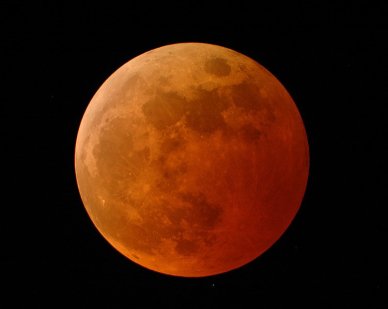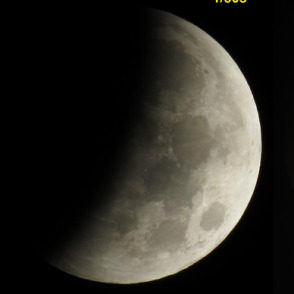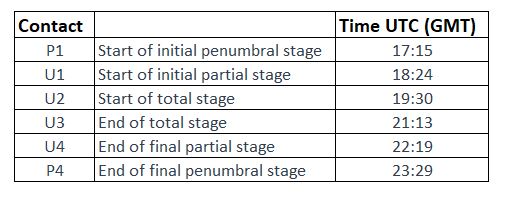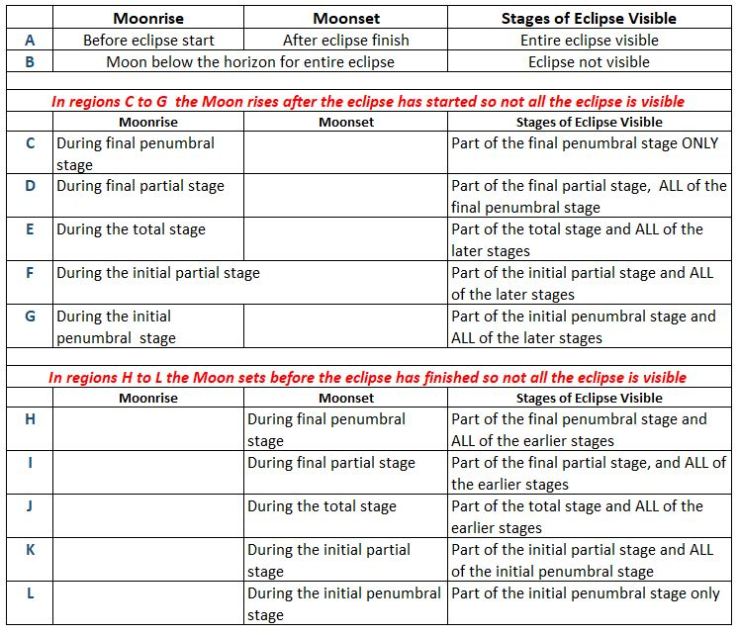On 27 July 2018 there will be a total eclipse of the Moon, which will be viewable from many areas of the world. This will be the first total lunar eclipse able to be observed in the UK for nearly three years and it will be worth making the effort to see, especially since, for viewers in Europe, Africa and eastern Asia, it will occur at a sociable hour in the evening.
The Moon during a recent total lunar eclipse – image from NASA
What happens during a lunar eclipse?
A lunar eclipse occurs when the Earth prevents some or all of the Sun’s light from hitting the Moon’s surface. This is shown in the diagram below:
Image from Wikimedia Commons
In this diagram in the region marked Umbra the Earth completely blocks the Sun. In the region marked Penumbra the Earth partially blocks the Sun.
The stages of the July 27 lunar eclipse
The next diagram below shows how, to someone on Earth, the Moon will move through the Earth’s shadow on 27 July. The six points labelled P1, U1, U2, U3, U4 and P4 are known as the eclipse contacts and are the times when the eclipse moves from one stage to the next.
Diagram from NASA
At point P1 the Earth will start to block some of the Sun’s light from reaching the Moon. This will start at 5:15 pm GMT and is the start of the penumbral phase. The Moon’s brightness will dim a little, but this will be quite difficult to notice with the naked eye.
As the Moon continues in its orbit, more and more of the Sun’s light is obscured, until after about an hour some of the Moon will get no direct sunlight. This is known as the partial phase. It will start at point U1 which will occur at 6:24 GMT. The part of the Moon which receives no direct sunlight will appear dark, as shown in the picture below.
.
The partial phase of a lunar eclipse – Image from Wikimedia Commons
After a further hour the Earth will block all direct sunlight from reaching the entire Moon. This is shown as U2 is the diagram and this total phase will start at 7:30 PM. In the total phase, rather than disappearing completely, the Moon goes a dull red colour as shown in the picture at the top of this post. This is because, even though no direct sunlight can reach the Moon, some light from the Sun is bent round the Earth’s atmosphere towards the Moon. This light appears red because visible light from the Sun is a mixture of different wavelengths – red light has the longest wavelength and violet the shortest. Most of the light of the shorter wavelengths (orange, yellow, green, blue, indigo and violet) is removed from this light bent by the Earth’s atmosphere by a process called scattering, which I discussed in an earlier post https://thesciencegeek.org/2015/09/30/why-is-the-sky-blue/ . The same effect causes the western sky to be red after sunset on a clear day.
Interestingly, if we could stand on the surface of the Moon and view the eclipse we would see a red ring around the Earth.
The Moon will emerge from the total phase (point U3) at 9:13 GMT, the partial phase (point U4) will end at 10:19 PM and the eclipse will finish (P4) at 11:29 PM.
Which areas of the world can see the eclipse?
The eclipse timings are summarised below
Data from NASA (2009)
Not all areas of the world will be able to see the eclipse. This is because the Moon will have already set after the eclipse starts or will not have risen before it finishes. Other places will only be able to see part of the eclipse.
- In Manchester where Mrs Geek and I live, the Moon will rise at 9:06 PM local times which is 8:06 PM GMT, so when the Moon rises the total eclipse will already be underway.
- In Manila, the Moon will set at 5:44 am on July 28, Philippine Standard Time (PST) which is 9:44 PM GMT, so viewers will miss part of the final partial phase because this will occur after the Moon has set.
I have adapted the diagram below from NASA (2009) and this shows where in the world the eclipse can be seen.
The regions labelled A to L are as follows
How often do lunar eclipses occur?
Even though the Moon takes roughly a month to orbit the Earth, lunar eclipses do not occur every month. The Moon’s orbit around the Earth is tilted at about five degrees with respect to the Earth’s orbit around the Sun, as shown below.
.
This means that during most lunar months, as seen from the Moon, the Earth passes just below or just above the Sun rather than obscuring it. There are only two time windows in a year when a lunar eclipse can occur. These two points are known as the nodes (See note 2). Even then most lunar eclipses are partial eclipses where the Earth only partially covers the Moon.
Notes
- GMT versus UTC
Although the term Greenwich Mean Time (GMT) is often used in popular writing it is no longer used by astronomers. Instead, they use two different times which agree with each other to within 1 second.
- Universal Time, often abbreviated to UT1, is the mean solar time, the time determined by the rising and setting of the Sun at the Greenwich Meridian, zero degrees longitude.
- Co-ordinated Universal Time, usually abbreviated to UTC, is the time measured by atomic clocks and is kept to within 1 second of UT1 by the addition of leap seconds.
In common use, GMT is often taken to be the same as UTC, which is the approach I have taken for this post. However, it can also be taken to mean UT1. Owing to the ambiguity of whether UTC or UT1 is meant, and because timekeeping laws usually refer to UTC, the term GMT is normally avoided in precise writing.
- Nodes when eclipses can occur
The two nodes when a lunar eclipse can occur aren’t the same dates every year but change from year to year due to an astronomical effect called precession of the line of nodes.
References
NASA (2009) Total lunar eclipse of 2018 July 2017, Available at: https://eclipse.gsfc.nasa.gov/LEplot/LEplot2001/LE2018Jul27T.pdf (Accessed: 8 July 2018).









Hi, interesting post, you said the next lunar eclipse will be Jan 21, will I be able to see it from the Philippines? I missed the eclipse on the 28th, didn’t know about it, but I’ll try to see the next if I’m able!
LikeLiked by 1 person
hi Tom,
Thanks for your comments and I’m glad that you are one of my many readers in the Philippines enjoying my blog.
Unfortunately, the next lunar eclipse on 21 Jan won’t be visible in the Philippines, but I will write a post about the next one which is – so my readers don’t miss out on seeing it.
Salamat sa pagbabasa ng aking blog !
The Science Geek
LikeLike
Hiya!
Excellent post!
Didn’t know all that about UT1 and UTC actually. Pretty interesting!
Sadly, it was too dusty in Kuwait (my country) so I didn’t notice a particularly red/orange tinge to the moon. The eclipse was exciting to witness, regardless!
LikeLiked by 1 person
Thank you for your feedback
LikeLike
I’ve seen a few of these but they’re always exciting to watch. I especially noted your comment about what the “eclipse” would look like from the moon. We don’t often think about things like that; it just goes to prove how self centred we are, w.r.t. cosmic phenomena as well as everything else. 🙂
LikeLiked by 1 person
Very true!
Let hope for clear skies on Friday
LikeLike
I’m not too far to the south of you so I think I’ll set my alarm for about 20.50 hrs. I believe too that Mars will be in opposition. (NASA)
LikeLiked by 1 person
[…] Science Geek has all you need to know about the full lunar eclipse on July 27th. As ever, there are some fine diagrams with some from NASA. There’s also a […]
LikeLiked by 1 person
[…] Source link […]
LikeLiked by 1 person
Reblogged this on The Somnium Project.
LikeLiked by 1 person
Nothing for us to see here in N America. I won’t lose any sleep. I hope your skies are clear that night.
LikeLiked by 1 person
Thanks!
You will be able to get a view of the lunar eclipse next January though!
Click to access LE2019Jan21T.pdf
LikeLike
Nice! Hope Wednesday evening turns into a starry night!
LikeLiked by 1 person
You will be in region F of the map -so yes you should see most of the eclipse. Weather permitting !
LikeLiked by 1 person
Thank you very much. Mrs. van Dijk and I will be in France at about 45 degrees N and 1 degree E. Do we have a good chance?
LikeLiked by 1 person